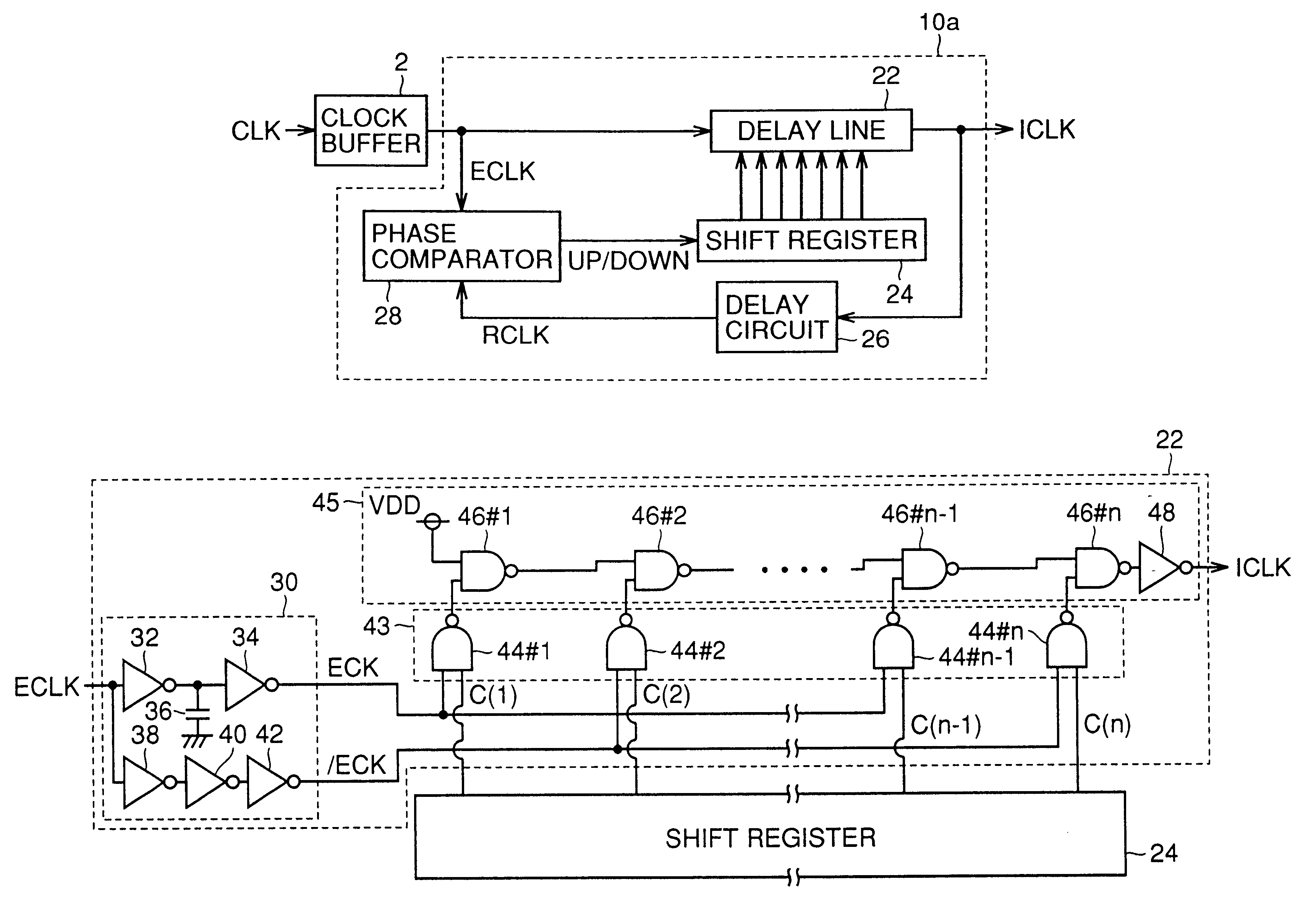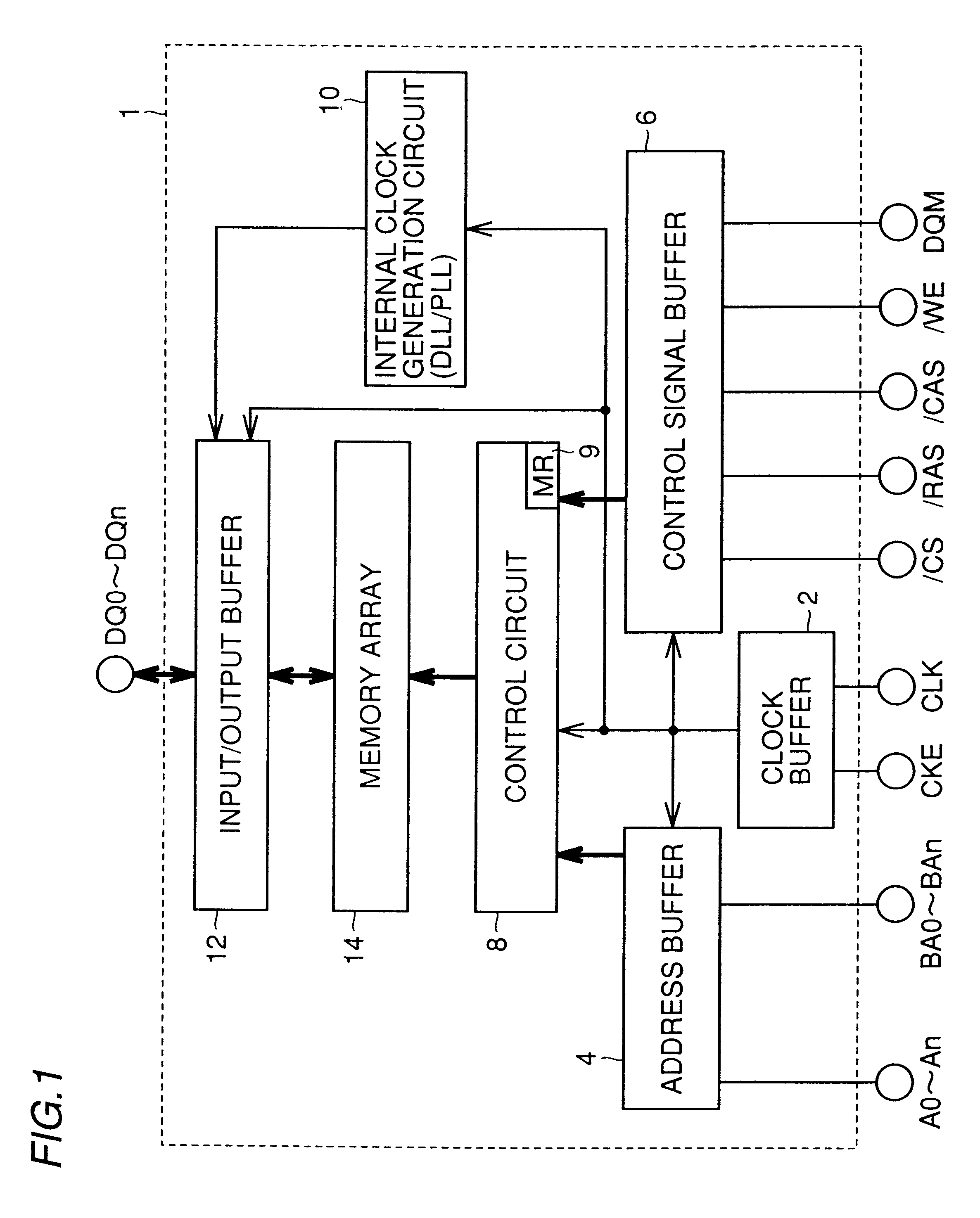Semiconductor device capable of generating highly precise internal clock
a technology of internal clock and semiconductor device, which is applied in the direction of generating/distributing signals, digital storage, instruments, etc., can solve the problems of unable to meet the operating speed of microprocessors (mpus), the inability to provide a more rapid internal clock signal for use internal to an sdram, and the inability to meet the requirements of microprocessors (mpus)
- Summary
- Abstract
- Description
- Claims
- Application Information
AI Technical Summary
Problems solved by technology
Method used
Image
Examples
first embodiment
FIG. 1 is a block diagram showing a schematic configuration of a semiconductor device 1 in the present invention.
As shown in FIG. 1, semiconductor device 1 is shown as exemplary, synchronous dynamic random access memory (SDRAM) synchronized with a clock signal to communicate data. Semiconductor 1 includes a clock buffer 2 receiving an external clock signal CLK and a clock enable signal CKE, an address buffer 4 receiving address signals A0-An (n is a natural number) and bank address signals BA0-BAn, and a control signal buffer 6 receiving control signals / CS, / RAS, / CAS, / WE, DQM. Address buffer 4 and the control buffer are synchronized with an output of clock buffer 2 to take in an address signal, a control signal and the like.
Semiconductor device 1 also includes an internal clock generation circuit 10 generating an internal clock signal in response to an output of clock buffer 2, a control circuit 8 synchronized with an output of clock buffer 2 to receive an output of address buffe...
second embodiment
When the power is turned on, with the delay line having its amount of delay set to be minimal, the DLL circuit starts adjusting a delay time, since locking with a large amount of delay would increase jitter. The delay line has an amount of delay varying depending on noise introduced into power supply potential. If the delay line provides a larger amount of delay, depending on the noise the amount of delay has a larger variation. As such in an initial state the delay line has its amount of delay minimized to start delay-time adjustment with an initial amount of delay minimized and lock a phase with the delay line having a possible smallest amount of delay.
FIGS. 10-12 are diagrams for illustrating a relationship between a clock period and an amount of delay.
As shown in FIG. 10, if a delay time is shorter than a period of an external clock then allowing the delay line to have an amount of delay initially minimized and then gradually increased allows a phase to be locked, with the delay...
third embodiment
While in the first embodiment a description has been provided of a DLL providing an adjustment using a single delay line having an amount of delay uniformly adjusted per step, there may be used a combination of a delay line changing an amount of delay in a fine step and a delay line providing delay varying in a large amount for providing coarse adjustment. Combining such delay lines advantageously allows a delay line to have a reduced number of selectors and the DLL circuit to have a reduced area penalty. However, a process variation and the like can result in the fine-adjustment delay line and the coarse-adjustment delay line having their respective amounts of delay failing to match and thus increasing jitter.
FIG. 18 is a circuit diagram showing a configuration of a DLL circuit 10c for use in the third embodiment.
As shown in FIG. 18, DLL circuit 10c receives externally applied clock signal CLK at clock buffer 2 and outputs internal clock signal ICLK.
DLL circuit 10c includes a fine ...
PUM
 Login to View More
Login to View More Abstract
Description
Claims
Application Information
 Login to View More
Login to View More - R&D
- Intellectual Property
- Life Sciences
- Materials
- Tech Scout
- Unparalleled Data Quality
- Higher Quality Content
- 60% Fewer Hallucinations
Browse by: Latest US Patents, China's latest patents, Technical Efficacy Thesaurus, Application Domain, Technology Topic, Popular Technical Reports.
© 2025 PatSnap. All rights reserved.Legal|Privacy policy|Modern Slavery Act Transparency Statement|Sitemap|About US| Contact US: help@patsnap.com



